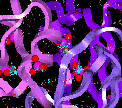 The AMBER Forcefield
The AMBER Forcefield
Contents
The standard AMBER forcefield, which is attributable to Kollman and
coworkers (Weiner et al. 1984,
1986) at the University of
California, San Francisco, is parameterized and defined only for
proteins and DNA. However, it has been widely used not only for
proteins and DNA, but also for many other classes of molecules, such
as polymers and small molecules. For the latter classes of molecules,
various authors have added parameters and extended AMBER in other ways
to suit their calculations. The AMBER forcefield has also been made
specifically applicable to polysaccharides (Homans 1990).
Functional Form
The coordinates and functional form of the energy terms used by AMBER
are given in Eq. 3-11.
- Eq. 3-11:
-

The first three terms in Eq. 3-11 handle the
internal coordinates of bonds, angles, and dihedrals. Term 3 is also
used to maintain the correct chirality and tetrahedral nature of
sp3 centers in the united-atom representation. In the
united-atom representation, nonpolar hydrogen atoms are not
represented explicitly, but are coalesced into the description of the
heavy atoms to which they are bonded. Terms 4 and 5 account for the
van der Waals and electrostatic interactions. The final term, 6, is a
hydrogen-bond term that augments the electrostatic description of the
hydrogen bond. This term in AMBER adds only about 0.5 kcal
mol-1 to the hydrogen-bond energy in AMBER, so the bulk of
the hydrogen-bond energy still arises from the dipole-dipole
interaction of the donor and acceptor groups.
AMBER Atom Types
The atom types in AMBER are quite specific to amino acids and DNA
bases. In the original publications, the atoms types and charges are
defined by means of diagrams of the amino acids and nucleotide
bases. In the Biosym/MSI environment, this information has been placed in
a residue library. Descriptions of the atom types, from the original
papers defining the AMBER forcefield, are shown in Table 3-4.
Table 3-4. Atom Types--AMBER
The format is:
- atom type
- description
and you may quickly jump to the classes of atom types by clicking:
- H
- amide or imino hydrogen
- HC
- explicit hydrogen attached to carbon
- HO
- hydrogen on hydroxyl oxygen
- HS
- hydrogen attached to sulfur
- HW
- hydrogen in water
- H2
- amino hydrogen in NH2
- H3
- hydrogen of lysine or arginine (positively charged)
- C
- sp2 carbonyl carbon and aromatic carbon with hydroxyl
substituent in tyrosine
- CA
- sp2 aromatic carbon in 6-membered ring with 1
substituent
- CB
- sp2 aromatic carbon at junction between 5- and
6-membered rings
- CC
- sp2 aromatic carbon in 5-membered
ring with 1 substituent and next to a nitrogen
- CK
- sp2 aromatic carbon in 5-membered
ring between 2 nitrogens and bonded to 1 hydrogen (in purine)
- CM
- sp2 same as CJ but one substituent
- CN
- sp2 aromatic junction carbon in
between 5- and 6-membered rings
- CQ
- sp2 carbon in 6-membered ring of
purine between 2 NC nitrogens and bonded to 1 hydrogen
- CR
- sp2 aromatic carbon in 5-membered
ring between 2 nitrogens and bonded to 1 H (in his)
- CT
- sp3 carbon with 4 explicit
substituents
- CV
- sp2 aromatic carbon in 5-membered
ring bonded to 1 N and bonded to an explicit hydrogen
- CW
- sp2 aromatic carbon in 5-membered
ring bonded to 1 N-H and bonded to an explicit hydrogen
- C*
- sp2 aromatic carbon in 5-membered
ring with 1 substituent
- CD
- sp2 aromatic carbon in 6-membered
ring with 1 hydrogen
- CE
- sp2 aromatic carbon in 5-membered
ring between 2 nitrogens with 1 hydrogen (in purines)
- CF
- sp2 aromatic carbon in 5-membered
ring next to a nitrogen without a hydrogen
- CG
- sp2 aromatic carbon in 5-membered
ring next to an N-H
- CH
- sp2 carbon with 1 hydrogen
- CI
- sp2 carbon in 6-membered ring of
purines between 2 NC nitrogens
- CJ
- sp2 carbon in pyrimidine at positions
5 or 6 (more pure double bond than aromatic with 1 hydrogen)
- CP
- sp2 aromatic carbon in 5-membered
ring between 2 nitrogens with one hydrogen (in his)
- C2
- sp2 carbon with 2 hydrogens
- C3
- sp2 carbon with 3 hydrogens
- N
- sp2 nitrogen in amide group
- NA
- sp2 nitrogen in 5-membered ring with
hydrogen attached
- NB
- sp2 nitrogen in 5-membered ring with
lone pairs
- NC
- sp2 nitrogen in 6-membered ring with
lone pairs
- NT
- sp2 nitrogen with 3 substituents
- N2
- sp2 nitrogen in base NH2 group or arginine
NH2
- N3
- sp2 nitrogen with 4 substituents
- N*
- sp2 nitrogen in purine or pyrimidine
with alkyl group attached
- O
- carbonyl oxygen
- OH
- alcohol oxygen
- OS
- ether or ester oxygen
- OW
- water oxygen
- O2
- carboxyl or phosphate nonbonded oxygen
- S
- sulfur in disulfide linkage or methionine
- SH
- sulfur in cystine
- P
- phosphorus in phosphate group
- CU
- copper ion (Cu+2 )
- CO
- calcium ion (Ca+2 )
- I
- iodine ion (I- )
- IM
- chlorine ion (Cl- )
- MG
- magnesium ion (Mg+2 )
- QC
- cesium ion (Cs+ )
- QK
- potassium ion (K+ )
- QL
- lithium ion (Li+ )
- QN
- sodium ion (Na+ )
- QR
- rubidium ion (Rb+ )
- LP
- lone pair
Extension of AMBER to Carbohydrates
Homans' forcefield for oligosaccharides (Homans 1990) has been
incorporated into the AMBER forcefield available in the
Discover program. It uses the same functional
form as AMBER and extends its applicability to polysaccharides and
glycoproteins. Homans' approach in developing the carbohydrate
forcefield was to combine the parameters for monosaccharides (Ha et al. 1988) with the results of
ab initio calculations on model compounds relevant to the glycosidic
linkage (Wiberg and Murcko
1989), to generate an AMBER-compatible forcefield. The bond,
angle, and torsion parameters for each monosaccharide residue were, in
general, taken directly from Ha et
al. (1988). However, certain parameters required adjustment and
others were added, to account for the glycosidic linkage between
contiguous monosaccharide residues. The torsion parameters were
adjusted to fit the quantum mechanical data (6-31G*) of Wiberg and Murcko (1980) for
dimethyloxymethane.
In addition, the carbohydrate forcefield utilizes charges and van der
Waals parameters derived for monosaccharides by Ha et al. (1988). Since the latter
parameters were derived without an explicit hydrogen-bonding term, the
carbohydrate forcefield also does not contain hydrogen-bonding
parameters.
To account for the anomeric effect associated with carbohydrates, the
linking atoms were defined as different atom types. Table 3-5 lists these atom types, as well as the
types corresponding to the ring atoms of sugars.
Table 3-5. Atom Types--Homans
The format is:
- atom type
- description
and you may quickly jump to the classes of atom types by clicking:
- AH
- a anomeric hydrogen
- BH
- b anomeric hydrogen
- HT
- sp2 hydrogen
- HY
- hydroxyl hydrogen
- AC
- a anomeric carbon
- BC
- b anomeric carbon
- CS
- sp2 carbon in sugar ring
- OA
- a anomeric oxygen
- OB
- b anomeric oxygen
- OE
- ring oxygen
- OT
- hydroxyl oxygen
Two aspects of the AMBER forcefield require special treatment in the
Discover program. First, all the 1-4 nonbond interactions are
scaled by a factor of 0.5 by default; and second, in most applications
a distance-dependent dielectric ( =
f (r)) is used. Thus, the denominator in Term 5 of Eq. 3-11 involves the square of the distance,
rather than just the distance as found in Coulomb's law. Another way
of looking at this term is that the dielectric ``constant'' is
=
f (r)) is used. Thus, the denominator in Term 5 of Eq. 3-11 involves the square of the distance,
rather than just the distance as found in Coulomb's law. Another way
of looking at this term is that the dielectric ``constant'' is  (r) =
(r) =  r.
r.
Scaling is done with the vdw_1_4 and coulomb_1_4
keywords of the forcefield
scale command.
 Main
access page
Main
access page  Theory/Methodology access.
Theory/Methodology access.
 Forcefields access
Forcefields access
 ESFF Forcefield
ESFF Forcefield
 Minimization
Minimization
Copyright Biosym/MSI
 The AMBER Forcefield
The AMBER Forcefield The AMBER Forcefield
The AMBER Forcefield Main
access page
Main
access page  Theory/Methodology access.
Theory/Methodology access.  Forcefields access
Forcefields access
 ESFF Forcefield
ESFF Forcefield
 Minimization
Minimization